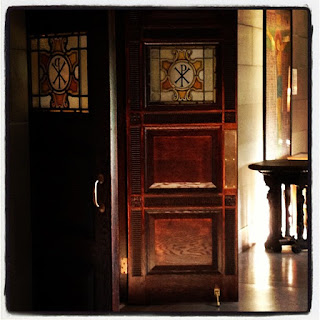A couple of weeks ago, PrayTell had a thought-provoking post on cognitive engagement and liturgy, based on a comparison between an experience of a Dominican rite liturgy in Latin and the current ordinary Roman Rite. Fritz Bauerschmidt's final questions offer, at least in my opinion, an implicit definition of excellent liturgy: "Can we craft liturgy that is clearly both something we do and something that sweeps us up in a movement quite independent of our efforts? Can our liturgy be intelligible without being mentally taxing? Can it be mysterious without being mystifying? Or is the quest for such a liturgy just tilting at windmills. I, for one, certainly hope not."
There was some suggestions in the comments that the old Latin masses (what these days is called the extraordinary form) were inherently more reverent and perhaps more silent. I responded to one such with by noting what I see as a tendency to conflate “contemplative/mystical” with the extraordinary form and “noisy/didactic” with the ordinary Roman rite.
Fr. Allen McDonald replied that "The silence of the EF Mass is different than the silences that should be observed in the OF such as before the penitential act, after the readings, the homily and Holy Communion." These are "silences just for the sake of silence"1 rather than silences which emerge from a properly prepared congregation contemplating "official prayers of the Church being prayed in a silent way."
I'm going to admit that I'm a bit put off by his characterization of the Eucharist as a contemplation (by the properly disposed) of someone else praying and gesturing in prayer. I say this even in the face of a memorable retreat where my own prayer was certainly sustained by meditating on the stalwart prayer of the sisters around me in the chapel.
That said, I'm grateful as his comments have made me attentive to the nature of the silence during Mass in my parish over the last two weeks. Silence is not what my community does because we should, it is our default stance in the celebration of the Eucharist, you can hear it (or rather not hear it) even between the words of the prayers. It's a silence that feels, in fact, not of our doing at all, but part and parcel of our being. Be still — let go your grasp — and know that I am God. (Ps 46:10) Here, at the Eucharistic table, we find ourselves in such intimate communion with God we cannot help but know that, and respond in kind. I think this might be what Fritz Bauerschmidt is getting at with his description of being swept into a mystery, where our own responses swell into the stillness and fade, where the presider's prayers cascade down the altar steps and wash over us, the chant swirls up and out, but all of it, ever and always pouring into a silence whose depth and breadth and height knows no bounds. Be still — be silent — and know that I am God.
1. Sacred silence in the Roman Missal, according to the GIRM, is not just for the sake of silence, but has a variety of purposes: "For in the Penitential Act and again after the invitation to pray, individuals recollect themselves; whereas after a reading or after the Homily, all meditate briefly on what they have heard; then after Communion, they praise God in their hearts and pray to him."
Photo is of the door to the chapel at the old Jesuit novitiate. A place that has held within its share of silent prayer and more...

Beautiful picture of the door! One of the pulls for me when I entered the Catholic church was the liturgy which is so scriptural. I am very surprised by my reaction to the Mass in that I was always very actively involved in the service when I was Protestant and robustly sang the hymns; however, now I contemplate a lot during the liturgy and find a great deal of "silence" of my own choosing. I appreciate the times of silence chosen by the celebrant but there is plenty of opportunity for my own silence. Thanks for this post.
ReplyDeleteThanks, Lynda...it's a gorgeous door and the light was just right!
DeleteI like to sing, but I, too, appreciate the silences, chosen and offered.
I never expected my reaction to Catholic liturgy when I was a Protestant. But I was drawn by the frame of it and it's rythyms. The pauses which I didn't initially recognize as silences were the moments I loved (and still love) best.
ReplyDeleteIt reminds me of John Cage's definition of music: the space between the notes....
DeleteFirst off, it can in no way be all things to all people... Much too large of a miracle. I will sit back and feel the silence at my church and if something moves me, will respond.
ReplyDeleteSilence and unsilence. Often a culturally defined thing. ;) I join in community at the Mass in a joyful celebration of shared faith -- which is why the Masses in Spanish, with Latino congregants, are my first, last and in-between choice. I sit in silence with God daily; I gather in His house weekly for the opposite of solitude. I prefer the Mass in vernacular (so I understand and follow rather than feel like a child spying on my betters), with music (also in vernacular) and facing the priest who is standing in persona Christi. And this too is reverence -- after all, is there anything more reverent than joy?
ReplyDeleteJoy is the surest sign of God before whom we fall in worship, after all!
DeleteI think of classes in which I have students who talk much, and those who talk little, but all add to the texture of the conversation (even when no one is saying anything!)
ReplyDelete